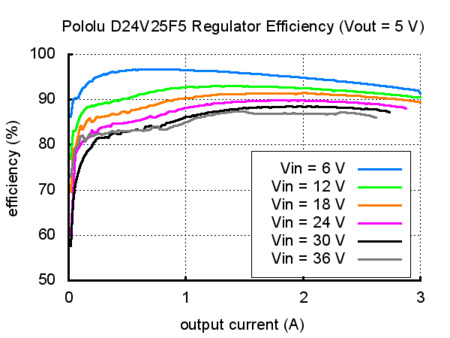5V, 2.5A Step-Down Voltage Regulator D24V25F5
SKU : D24V25F5
| Price |
1,150.00 ฿ |
| Quantity to buy | |
| Total | 1,150.00 ฿ |
Do not have enough stock
Out of stock
This small synchronous switching step-down (or buck) regulator takes an input voltage of up to 38 V and efficiently reduces it to 5 V. The board measures only 0.7″ × 0.7″, but it allows a typical continuous output current of up to 2.5 A. Typical efficiencies of 85% to 95% make this regulator well suited for powering moderate loads like sensors or small motors. High efficiencies are maintained at light loads by dynamically changing the switching frequency, and an optional shutdown pin enables a low-power state with a current draw of a few hundred microamps.
Overview
This step-down (buck) regulator generates a fixed 5 V output from input voltages up to 38 V. It is a switching regulator (also called a switched-mode power supply (SMPS) or DC-to-DC converter) and has a typical efficiency between 85% to 95%. The available output current is a function of the input voltage and efficiency (see the Typical Efficiency and Output Current section below), but the input current can typically be as high as 2.5 A. The regulator has a typical quiescent current draw of less than 1 mA, and the ENABLE pin can be used to put the board in a low-power state that reduces the quiescent current to approximately 10 µA to 20 µA per volt on VIN.
Two larger, higher-power versions of this regulator are also available: one with a typical maximum output current of 6 A, and the other with a typical maximum output current of 9 A. The higher-power versions also have a few additional features, like a “power good” signal and the ability to lower their output voltage.
This regulator has built-in reverse-voltage protection, short-circuit protection, thermal shutdown, a soft-start feature that reduces inrush current, and an under-voltage lockout that causes the regulator to turn off when the input voltage is below 4.2 V (typical).
Features
- Input voltage: 6 V to 38 V (see below for more details on the regulator’s dropout voltage, which affects the low end of the operating range)
- Fixed 5 V output (with 4% accuracy)
- Typical maximum continuous output current: 2.5 A
- Integrated reverse-voltage protection, over-current protection, over-temperature shutoff, soft-start, and under-voltage lockout
- Typical efficiency of 85% to 95%, depending on input voltage and load; the switching frequency automatically changes at light loads to maintain high efficiencies
- 700 μA typical no-load quiescent current; can be reduced to 10 µA to 20 µA per volt on VIN by disabling the board
- Compact size: 0.7″ × 0.7″ × 0.35″ (17.8 mm × 17.8 mm × 8.8 mm)
- Two 0.086″ mounting holes for #2 or M2 screws
Using the regulator
Connections
This boost regulator has four different connections: input voltage (VIN), ground (GND), output voltage (VOUT) and enable (EN).
 The input voltage, VIN, powers the regulator and can be supplied with voltages up to 38 V. The effective lower limit of VIN is VOUT plus the regulator’s dropout voltage, which varies approximately linearly with the load from around 700 mV to 1.6 V (see below for a graph of the dropout voltages as a function of the load).
The input voltage, VIN, powers the regulator and can be supplied with voltages up to 38 V. The effective lower limit of VIN is VOUT plus the regulator’s dropout voltage, which varies approximately linearly with the load from around 700 mV to 1.6 V (see below for a graph of the dropout voltages as a function of the load).
The regulator is enabled by default: a 100 kΩ pull-up resistor on the board connects the ENABLE pin to reverse-protected VIN. The ENABLE pin can be driven low (under 0.6 V) to put the board into a low-power state. The quiescent current draw in this sleep mode is dominated by the current in the pull-up resistor from ENABLE to VIN and by the reverse-voltage protection circuit, which will draw between 10 µA and 20 µA per volt on VIN when ENABLE is held low. If you do not need this feature, you should leave the ENABLE pin disconnected.
 Pololu 5V, 2.5A Step-Down Voltage Regulator D24V25F5 with included hardware.
Pololu 5V, 2.5A Step-Down Voltage Regulator D24V25F5 with included hardware. Pololu 5V, 2.5A Step-Down Voltage Regulator D24V25F5, bottom view.The five connections are labeled on the top of the PCB and are arranged with a 0.1″ spacing for compatibility with solderless breadboards, connectors, and other prototyping arrangements that use a 0.1″ grid. Either the included 5×1 straight male header strip or the 5×1 right angle male header strip can be soldered into these holes. For the most compact installation, you can solder wires directly to the board.
Pololu 5V, 2.5A Step-Down Voltage Regulator D24V25F5, bottom view.The five connections are labeled on the top of the PCB and are arranged with a 0.1″ spacing for compatibility with solderless breadboards, connectors, and other prototyping arrangements that use a 0.1″ grid. Either the included 5×1 straight male header strip or the 5×1 right angle male header strip can be soldered into these holes. For the most compact installation, you can solder wires directly to the board.
 Pololu 5V, 2.5A Step-Down Voltage Regulator D24V25F5, side view.The board has two 0.086″ mounting holes intended for #2 or M2 screws. The mounting holes are at opposite corners of the board and are separated by 0.53″ both horizontally and vertically.
Pololu 5V, 2.5A Step-Down Voltage Regulator D24V25F5, side view.The board has two 0.086″ mounting holes intended for #2 or M2 screws. The mounting holes are at opposite corners of the board and are separated by 0.53″ both horizontally and vertically.
Typical efficiency and output current
The efficiency of a voltage regulator, defined as (Power out)/(Power in), is an important measure of its performance, especially when battery life or heat are concerns. As shown in the graph below, these switching regulators have an efficiency of 85% to 95% for most combinations of input voltage, and load.
 The maximum achievable output current of the board depends on many factors, including the ambient temperature, air flow, heat sinking, and the input and output voltage.
The maximum achievable output current of the board depends on many factors, including the ambient temperature, air flow, heat sinking, and the input and output voltage.
During normal operation, this product can get hot enough to burn you. Take care when handling this product or other components connected to it.
The over-current limit of the regulator operates on a combination of current and temperature: the current threshold decreases as the regulator temperature goes up. However, there might be an operating point at approximately 6.5V in and 4A out where the current is just under the limit and the regulator might not shut off before damage occurs. If you are using this regulator in an application where the input voltage is near the lower limit and the load could exceed 3.5A for sustained periods (more than five seconds), consider using additional protective components such as fuses or circuit breakers.
Typical dropout voltage
The dropout voltage of a step-down regulator is the minimum amount by which the input voltage must exceed the regulator’s target output voltage in order to ensure the target output can be achieved. For example, if a 5 V regulator has a 1 V dropout voltage, the input must be at least 6 V to ensure the output is the full 5 V. The following graph shows the dropout voltages for the D24V60F5 regulator as a function of the output current:
 Switching frequency and behavior under light loads
Switching frequency and behavior under light loads
The regulator generally operates at a switching frequency of around 470 kHz, but the frequency drops when encountering a light load to improve efficiency. This could make it harder to filter out noise on the output caused by switching.
Dimensions
- Size: 0.7″ × 0.7″ × 0.35″1
- Weight: 2.6 g1
General specifications
- Minimum operating voltage: 6 V2
- Maximum operating voltage: 38 V
- Continuous output current: 2.5 A3
- Output voltage: 5 V
- Reverse voltage protection?: Y
- Maximum quiescent current: 15 mA4
Notes:
1.Without included optional headers.
2.For small loads; this voltage rises approximately linearly up to around 6.4 V at 2.5 A output.
3.Typical. Actual continuous output current limited by thermal dissipation.
4.Typical worst case (i.e. with VIN close to 5V). Quiescent current depends on the input and output voltages and is much lower for most of the input voltage range (typically below 1 mA). The ENABLE pin can be used to reduce the quiescent current to a few hundred microamps.


